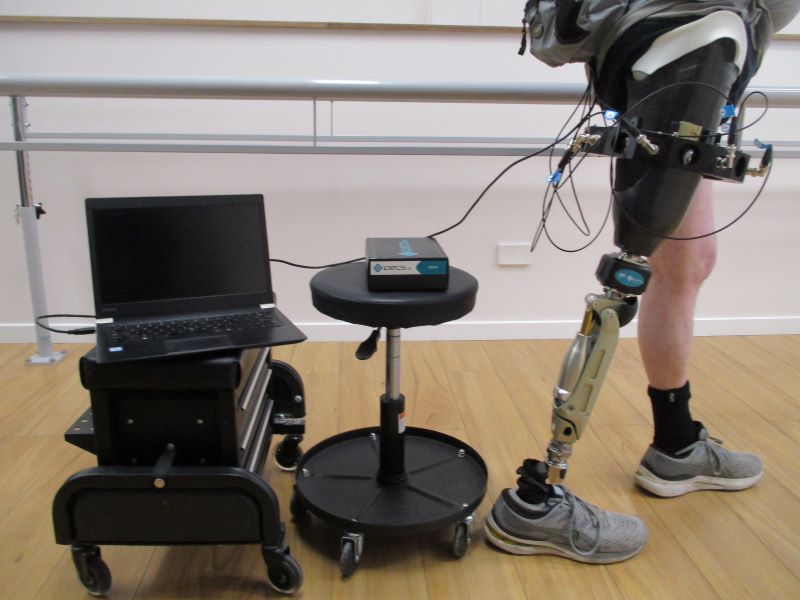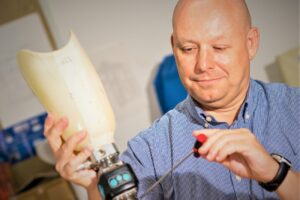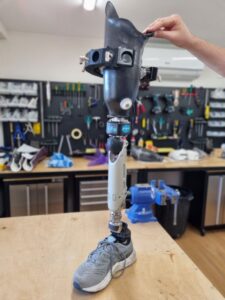
Griffith researchers have developed a groundbreaking diagnostic tool to streamline the custom fitting of bionic prosthetic limbs which usually involve an arduous process of trial and error.
The Griffith Centre of Biomedical and Rehabilitation Engineering (GCORE) and Menzies Health Institute Queensland have reached a milestone with the successful fitting of a bionic limb using the new diagnostic and digital twin system.
Streamlining the process:
- The team generated a digital twin (virtual replica) of the patient’s residuum (the amputee’s stump) to create a custom 3D printed bionic limb.
- A direct skeletal attachment was surgically implanted into the patient’s living bone, which would enable the external attachment to the patient’s bionic prosthesis.
- The new artificial limb was then successfully fitted, and the specially designed diagnostic software used to test and assess the fitting, measuring the movement of the patient’s bones, muscles, tendons, fat, and skin.
Controlled with a microprocessor, the bionic limb is a robotic-like artificial joint.
The system aims to improve function and mobility, thereby, the quality of life of prosthetic users while potentially reducing health care expenses associated with limb loss.

Bionic limbs scientist Professor Laurent Frossard is passionate about developing ground-breaking prosthetic solutions and said the new device was a cost-effective solution because it efficiently streamlines the patient’s care and fitting procedures.
“Until now, there have been few reliable, practical and affordable ways to determine the stress being imposed by a prosthesis on the residuum’s internal tissues,” Professor Frossard said.
“The health and comfort of the patient’s residuum is an ongoing problem for people who wish to use a prosthetic limb.”
Traditionally, medical professionals have relied on a process of physical examinations, medical tests and expensive medical imaging, like Xray to assess health issues affecting a patient’s residuum.
“A bionic solution is a technological platform relying on three interconnected pillars: the muscle control (“the engine”), the direct skeletal attachment (“the chassis”), and the prosthetic device (“power assisted steering wheel”),” Professor Frossard said.
 “This device is key to providing patients with a radically new and empowering experience because it allows understanding of the way their bionic prostheses interacts with, and impacts on their residuum tissue.
“This device is key to providing patients with a radically new and empowering experience because it allows understanding of the way their bionic prostheses interacts with, and impacts on their residuum tissue.
“With the new technology, clinicians can help the patient understand how the load and pressure from the prosthesis stimulates the residuum during fitting of prosthesis and guide them to pain-free use during movements.
“The device provides a means to increase the ability of walking effortlessly and quality of life for individuals suffering from typical and regular issues that compromise the health of their residuum.
“The diagnostic device will be particularly helpful to assist young, active and former military personal who lost their limbs in recent wars and facing a lifetime of prosthetic use.”
The project team includes GCORE Coresearchers Christian Langton, Rod Barrett, David Lloyd, Robert Ware, Gold Coast Custom Prosthetics and Metro North Health’s Jamieson Trauma Institute, and funded by US Department of Defense (Award No. W81XWH2110215-DM190659), Bionics Queensland / Bionics Gamechangers Australia (Bionics Queensland Challenge 2021 Major Prize – Mobility) and the Australian ³Ô¹ÏÍøÕ¾ Member Society of the International Society for Prosthetics and Orthotics (Research Grant awarded in 2021).








